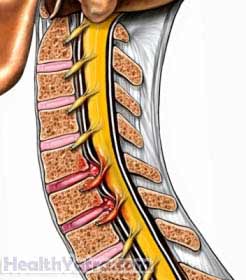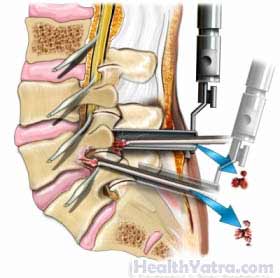تعريف
A laminectomy is a surgery to remove a small portion of a vertebra (back bone). The part removed is called the lamina.

أسباب هذا الإجراء
A laminectomy is usually done to help take pressure off your spinal cord or a nerve running out from your spinal cord. It is also done to gain access to the spinal cord, bones, and discs that are below the lamina. Ruptured discs, bony spurs, or other problems can cause narrowing of the canals that the nerves and spinal cord run through. This can irritate the nerve if it gets too narrow. Often, a laminectomy is done along with a disk removal to help make the canal larger and take pressure off the nerve being irritated.
When the spinal cord or other nerves get irritated, they can cause:
- ضعف
- خدر
- Pain in an arm or leg
Physical therapy and medicine will be tried first. The surgery is done when other treatments have not worked. It is most often done to treat symptoms that keep getting worse.
المضاعفات المحتملة
Complications are rare, but no procedure is completely free of risk. If you are planning to have a laminectomy, your سيقوم الطبيب بمراجعة القائمة من المضاعفات المحتملة، والتي قد تشمل:
- العدوى
- نزيف
- Blood clots
- Damage to nerves, resulting in pain, numbness, tingling, or paralysis
- Problems related to anesthesia
تشمل العوامل التي قد تزيد من خطر حدوث مضاعفات ما يلي:
تأكد من مناقشة هذه المخاطر مع طبيبك قبل الجراحة.
ما يمكن توقعه
قبل الإجراء
قد يقوم طبيبك بما يلي:
- اختبار بدني
- الأشعة السينية - اختبار يستخدم الإشعاع لالتقاط صورة للبنى داخل الجسم ، وخاصة العظام
- فحص التصوير بالرنين المغناطيسي – اختبار يستخدم الموجات المغناطيسية لالتقاط صور لداخل الجسم
- Myelogram—a specialized type of x-ray that requires dye to be inserted near the spinal cord and shows if there is pressure on the cord or the nerves
- CT scan—a type of x-ray that uses a computer to make pictures of the inside of the body
In the time leading up to your surgery:
- If you are overweight, try to lose weight. This will decrease the amount of stress on your back.
- Talk to you doctor about your medicines. You may need to stop taking aspirin or other anti-inflammatory drugs for one week before surgery. You may also need to stop blood-thinning drugs, like clopidogrel (Plavix) or warfarin (Coumadin).
- Arrange for a ride home and for help at home.
- Eat a light meal the night before. Avoid eating or drinking anything after midnight.
التخدير
Possible types of anesthesia for this operation include:
- General anesthesia—blocks pain and keeps you asleep during the surgery; given through an IV in your hand or arm
- Spinal anesthesia—numbs the area from the chest down to the legs; given as an injection in your back
وصف الإجراء
If the surgery is done with minimally invasive techniques, you will only need a few small incisions. The doctor will insert a scope and small instruments into these incisions. The lamina will then be removed using a drill or other tools. Once the lamina is removed, the doctor can inspect the spinal cord and discs that were hidden under the lamina.
In some cases, the doctor will do an جراحة مفتوحة. This involves making a larger cut in the skin over the area in the back that needs attention.
The disc often needs to be removed as well to take pressure off the spinal cord. If it is not a disc problem, the doctor will try to fix the other problems causing the nerve irritation. In rare cases, the doctor may do a spinal fusion. A spinal fusion will involve joining two vertebrae. Lastly, the incision will be closed with stitches or staples.

كم من الوقت سيستغرق ؟
1-3 ساعات
كم هو مؤلم ؟
You will have pain during recovery. Your doctor will give you pain medicine.
متوسط الإقامة في المستشفى
هذا surgery is done in a hospital setting. The usual length of stay is 1-3 days. Your doctor may choose to keep you longer if there are complications.
رعاية ما بعد العملية
في المستشفى
أثناء تعافيك في المستشفى ، قد تتلقى الرعاية التالية:
- You will have to walk with assistance the evening after surgery or the next day.
- You may need to wear a back or neck brace.
- You may need to wear special socks or boots. These will help to prevent blood clots.
في البيت
When you return home, do the following to help ensure a smooth recovery:
- تأكد من اتباع تعليمات طبيبك.
- حافظ على منطقة الشق نظيفة وجافة.
- اسأل طبيبك حول, عندما هي آمنة للاستحمام, السباحة, أو نقع في الماء.
- Exercise your legs while in bed. This is to improve circulation and decrease the risk of blood clots.
- Do not lift anything heavy.
- Work with a physical therapist. You will slowly progress from walking to other low-impact activities, like swimming.
- Only take medicine recommended by your doctor. Ask your doctor before taking any over-the-counter medicine.
- Have the stitches or staples removed in two weeks.
استدعاء الطبيب
بعد مغادرة المستشفى، اتصل بطبيبك في حالة حدوث أي مما يلي:
- علامات الإصابة, بما في ذلك حمى وقشعريرة
- احمرار أو تورم أو ألم متزايد أو نزيف شديد أو أي إفرازات من موقع الشق
- الغثيان و / أو القيء الذي لا يمكنك السيطرة عليه بالأدوية التي أعطيت لك بعد الجراحة ، أو التي تستمر لأكثر من يومين بعد الخروج من المستشفى
- ألم لا يمكنك السيطرة عليه بالأدوية التي أعطيت لك
- سعال وضيق في التنفس وألم في الصدر
- Trouble urinating or having a bowel movement
- New numbness or weakness in the hips, groin, or legs
- آلام المفاصل ، والتعب ، والتصلب ، والطفح الجلدي ، أو غيرها من الأعراض الجديدة
في حالة الطوارئ ، اتصل على المساعدة الطبية على الفور.
